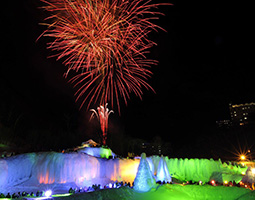February 2023
- English
- 日本語
The Sounkyo Onsen Icefall Festival

Illuminated ice artworks at the Sounkyo Onsen Icefall Festival in Kamikawa, Hokkaido 
Illuminated ice artworks

Fireworks explode over the festival venue 
A tunnel of illuminated icicles

A festival is held in snowy Sounkyo, Hokkaido in the winter in which artworks formed from ice are illuminated at night, creating a magical spectacle.

There are three large, famous events to enjoy in the winter in Hokkaido: the Sapporo Snow Festival*, the Asahikawa Winter Festival, and the Sounkyo Onsen Icefall Festival. While the events in Sapporo and Asahikawa involve the creation of snow sculptures, the event in Sounkyo is characterized by the use of nature in creating ice artworks of different kinds. These artworks, numbering around 30 in total, are formed and then grow from multiple icicles, sometimes to as big as 50 meters wide and 13 meters tall. Around 120,000 visitors come each year to see this powerful, extraordinary spectacle.
Sounkyo, located in the town of Kamikawa almost exactly in the center of Hokkaido, is part of the Daisetsuzan National Park**. Located in the upper part of the Ishikari River, the longest river in Hokkaido, the Sounkyo gorge features around 24 kilometers of precipitous cliffs carved out by the flow of the river over a long period of time. The area is also famous for its hot springs that supply the Sounkyo Onsen hot spring resort.
Nakajima Shinichi, executive director of the Sounkyo Tourism Association, says that “the temperatures in this area drop below -10°C in February and with wind chill it can feel like -20. This is why tourists mainly visited in the summer. But we also wanted tourists to come in the winter. With that in mind, a group of young men from the Sounkyo shopping district held an event with artist Takenaka in 1976, and this is how the Icefall Festival started.”

Takenaka Toshihiro (1931–2002) was a sculptor based in Eniwa City, Hokkaido, and at the time was working on ice-covered tree sculptures by spraying trees with water and letting them freeze. Takenaka’s sculpted ice-covered tree exhibition held in Sounkyo was well received, and since then, it has been held each year as the Icefall Festival. The number of visitors has increased each time, and the event has grown in scale to the point that nowadays the event is held from the end of January until early March, at a special venue next to the Ishikari River. This year will mark the 48th time the event has been held.
Nowadays, the ice artworks are planned and created by an executive committee made up of local residents. Preparations begin in autumn of the preceding year. Once the theme for the festival has been decided upon, work on constructing the logs that will become the molds for the ice artworks begins in early November. From December, water taken from the Ishikari River is sprayed onto the completed framework and the hanging icicles slowly increase in size. The artworks are complete in about one and a half months.
“Parts that are to become pathways and stairs are cut with chainsaws, but we generally do not alter any of the completed ice artworks. We want visitors to enjoy the sight of the rough ice made by nature in the cold of nature,” says Nakajima.
An icefall generally refers to a waterfall that has frozen over. The name “Icefall Festival” given to this ice sculpture event in Sounkyo was derived from the way the ice artworks express this natural phenomenon.

When the white ice artworks made from the clear waters of the Ishikari River are illuminated, a multi-colored, fantastical scene emerges. The fireworks launched in the frozen night during the festival are also famous. Many tourists stay overnight to enjoy the Icefall Festival.
“The Icefall Festival has become a very important event for local residents, as it has been held continuously without any cancellations, held even during the coronavirus outbreak with infection prevention measures in place,” says Nakajima.
The number of overseas tourists was also increasing before the coronavirus outbreak, and visitors enjoyed the Sounkyo ice artworks that had an impact different from that of the snow sculptures of the snow festivals. There are also events related to the local area held on the weekends during the festival, including Kamikawa Ainu*** drum performances. An additional charm of Sounkyo lies in the fact that there are hot springs to visit and warm the body after enjoying the festival.
* See Highlighting Japan January 2022, “The Sapporo Snow Festival” https://www.gov-online.go.jp/eng/publicity/book/hlj/html/202201/202201_02_en.html
** See Highlighting Japan September 2022, “The Autumn Leaves of Mt. Asahidake, Hokkaido” https://gov-online.go.jp/eng/publicity/book/hlj//html/202209/202209_02_en.html
*** The indigenous people around the northern region of the Japanese archipelago, particularly Hokkaido, are called the Ainu people, and in the Kamikawa Basin at the foot of Daisetsuzan, there lived a people called the “Kamikawa Ainu”.

